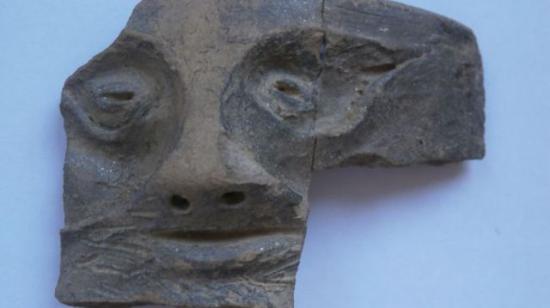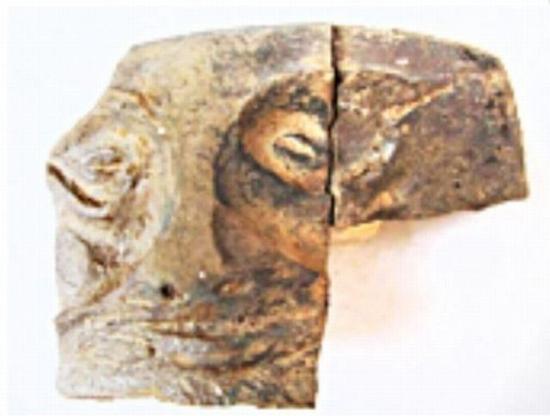Ivan Dikov
Source - http://archaeologyinbulgaria.com/2015/09/20/archaeologists-discover-satyr-mask-in-ancient-greek-emporium-pistiros-in-thracians-odrysian-kingdom-near-bulgarias-vetren/
 This mask of a satyr, a male companion of wine god Dionysus with equine features, which is in fact a fragment from a ceramic vessel, has been found during the 2015 summer excavations of emporium Pistiros near Vetren in Southern Bulgaria, an Ancient Greek trading post deep into the territory of the Ancient Thracian Odrysian Kingdom, which saw its height in the 4th century BC. Photo: Kmeta
This mask of a satyr, a male companion of wine god Dionysus with equine features, which is in fact a fragment from a ceramic vessel, has been found during the 2015 summer excavations of emporium Pistiros near Vetren in Southern Bulgaria, an Ancient Greek trading post deep into the territory of the Ancient Thracian Odrysian Kingdom, which saw its height in the 4th century BC. Photo: Kmeta
A mask of a satyr, a male companion of ancient wine god Dionysus with horse-like features, has beendiscovered by archaeologists near the town of Vetren in Southern Bulgaria during the 2015 summer excavations of Pistiros, an Ancient Greek emporium, i.e. a trading post, inside what once was theAncient Thracian Odrysian Kingdom.
An emporium (in Latin; “emporion” in Greek) was a settlement reserved as a trading post, usually for the Ancient Greeks, on the territory of another ancient nation, in this case the Ancient Thracian Odrysian Kingdom (5th century BC – 1st century AD), the most powerful Thracian state.
Pistiros was set up as an emporium by Ancient Greek merchants from the Aegean Island of Thasos in the 5th century BC, and saw its height in the 4th century BC under the protection of the Thracian Odrysian Kings. It was destroyed in 279-278 BC by the Celts, and never recovered as an emporium; anAncient Thracian metallurgical settlement was built there in its stead.
The ruins of emporium Pistiros were discovered in 1988 by Polish-Bulgarian archaeologist Mieczyslaw Domaradzki.
The satyr mask from emporium Pistiros has been found on a fragment from a ceramic vessel, reports local news site Kmeta.
It has been discovered by archaeologist Gavrail Lazov from Bulgaria’s National Museum of History in Sofia.
“This find is unique for Bulgaria,” says Valentina Taneva, Director of the Mieczyslaw Domaradzki Museum of Archaeology, also known as the Septemvri Museum of Archaeology, in the southern Bulgarian town of Septemvri, who is also among the participants in the digs.
The satyr mask relief was in fact situated high at the mouth of the ceramic vessel, on its outer side. It clearly depicts a human face with a nose and a mouth.
 Another photo of the satyr mask found during the 2015 summer excavations of emporium Pistiros, the Ancient Greek trading post in the Ancient Thracian Odrysian Kingdom, whose ruins are located near today’s Bulgarian town of Vetren, Septemvri Municipality, Pazardzhik District. Photo: Zname daily
Another photo of the satyr mask found during the 2015 summer excavations of emporium Pistiros, the Ancient Greek trading post in the Ancient Thracian Odrysian Kingdom, whose ruins are located near today’s Bulgarian town of Vetren, Septemvri Municipality, Pazardzhik District. Photo: Zname daily
The 2015 digs at the Ancient Greek emporium Pistiros in the Odrysian Kingdom of the Ancient Thracians have yielded a number of other intriguing finds as well, in addition to the mask of the satyr,the mythical companion of wine god Dionysus.
One of them is a bronze application of a horse ammunition depicting a griffin head which is dated to the end of the 5th century BC.
Other artifacts discovered by the archaeologists near the town of Vetren, Septemvri Municipality, Pazardzhik District, include silver and bronze coins, a ring, fibulas, and loom weights.
The archaeologists have also found Ancient Greek ceramics with various images, reports the local daily Zname.
Lead archaeologist Aleksey Gotsev and his colleague Vyara Petrova have excavated archaeological structures containing evidence of three time periods in the history of the Ancient Greek emporium in the Odrysian Kingdom of the Ancient Thracians.
They are yet to fully explain the different stages of the development of the ancient city near Bulgaria’s Vetren.
The upper-most archaeological layer contains remains of stone structures from the 4th century BC.
The archaeologists have come across a two-meter deep pit containing broken tiles which they have extracted in order to examine them.
The 2015 summer archaeological excavations have marked the 27th archaeological season since the discovery of emporium Pistiros back in 1988, an untypical Ancient Greek trading post because of its location so deep into the territory of the Ancient Thracian Odrysian Kingdom.